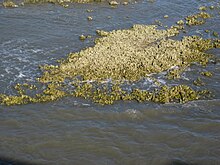Oyster reef

The term oyster reef refers to dense aggregations of
Degradation of oyster reefs
Oyster reefs were once common in estuaries around the world.
In the United States Crassostrea virginica, the
The
Oyster reef ecology
Natural oyster reefs are composed of living and dead oyster shells and provide important habitat for various species.[5] For example, the complex three-dimensional interstitial spaces within oyster reefs provide refugia for prey or juvenile species, which increases prey biomass and thereby enhances trophic transfer. Oyster reefs also stabilize shorelines by promoting sediment deposition and buffering wave energy, thereby allowing other habitats such as sea grass beds and marsh areas to form while simultaneously decreasing erosion of the shoreline.[9][10][11][12]
Ecosystem services
The filter feeding behavior of oysters can buffer against environmental degradation caused by human-induced eutrophication of estuary systems. Oysters feed on suspended phytoplankton and other organic matter. Disruption of the filter feeding by oysters can lead to a decrease in the elimination of organic matter from the water column and increase phytoplankton abundance. This in turn may lead to seasonal anoxia, which could increase mortality for other estuary animals, such as fish.[5]
Oyster reefs can also impact the carbon sequestration and excess nutrient uptake. Oyster reefs also stabilize shorelines by promoting sediment deposition and buffering wave energy, thereby allowing other habitats such as sea grass beds and marsh areas to form while simultaneously decreasing erosion of the shoreline.[9][13][14][15] Oyster reef habitats have been recognized as green infrastructure for shoreline protection.[16]
Restoration
Oyster reef restoration has accelerated in recent decades.[17] Oyster reef restoration projects often place the sanitized shells of dead oysters, concrete, or limestone pieces on a soft bottom to encourage oyster spat settlement.[10] Restoration of intertidal eastern oyster reefs can match natural densities of oysters and mud crabs, and recover oyster stability in about 6 years.[18] Additional benefits to restoring these habitats includes suppressing phytoplankton blooms via increasing filter feeding behavior,[19] increase nutrient sequestration and denitrification rates,[20] increase nekton biomass, and potentially increase commercial fishery value.[21] However, data on previously implemented restoration projects can be difficult to access, hindering future restoration efforts.[22]
See also
- Rudists – extinct group of major reef-building bivalves in the Mesozoic Era
References
- ^ S2CID 4993209.
- PMID 15326294.
- ^ a b "Notes from the Field: Indian River Lagoon Oyster Reef Restoration Project" (PDF). The Nature Conservancy Indian River Lagoon Program. Retrieved 29 January 2023.
- ^ Boudreaux, Michelle L. (2005). Native and Invasive Competitors of the Eastern Oyster Crassostrea virginica in Mosquito Lagoon, Florida (MSc thesis). Orlando: University of Central Florida. 532. Retrieved 30 January 2023 – via UCF STARS.
- ^ .
- PMID 15326294.
- hdl:10072/416403.
- ISSN 2351-9894.
- ^ .
- ^ S2CID 84109311.
- .
- S2CID 54732481.
- S2CID 84109311.
- .
- S2CID 54732481.
- ISSN 1758-678X.
- S2CID 233279016.
- S2CID 247990521.
- S2CID 22032465.
- .
- PMID 26336635.
- .
